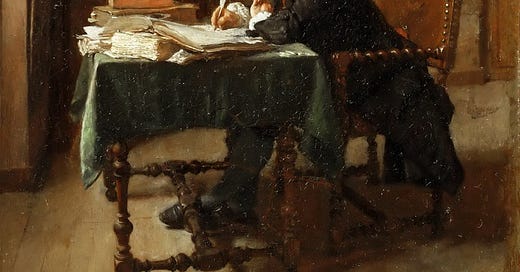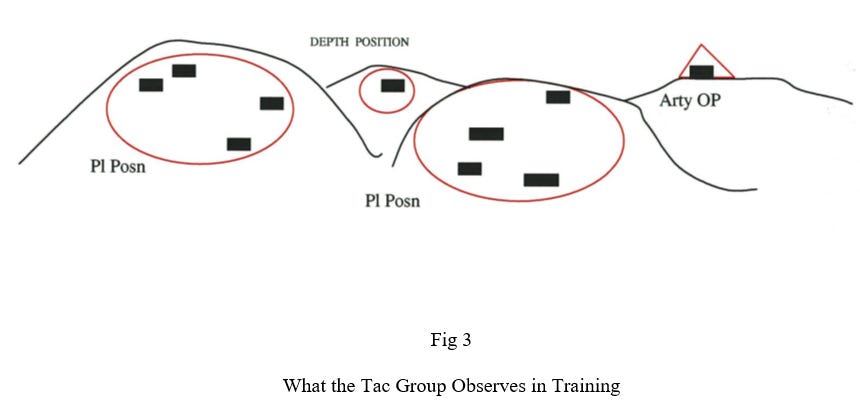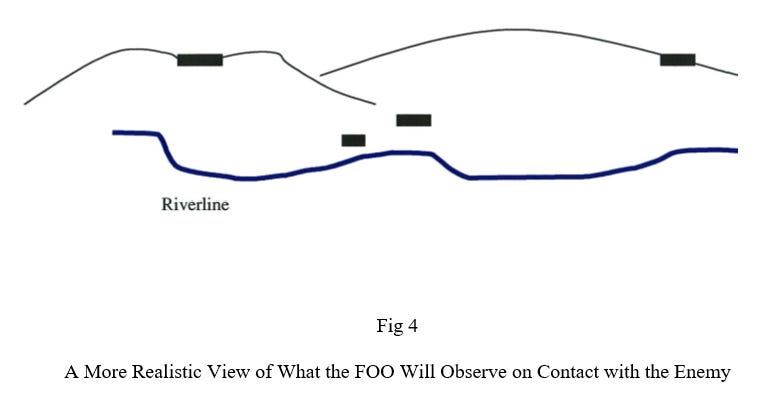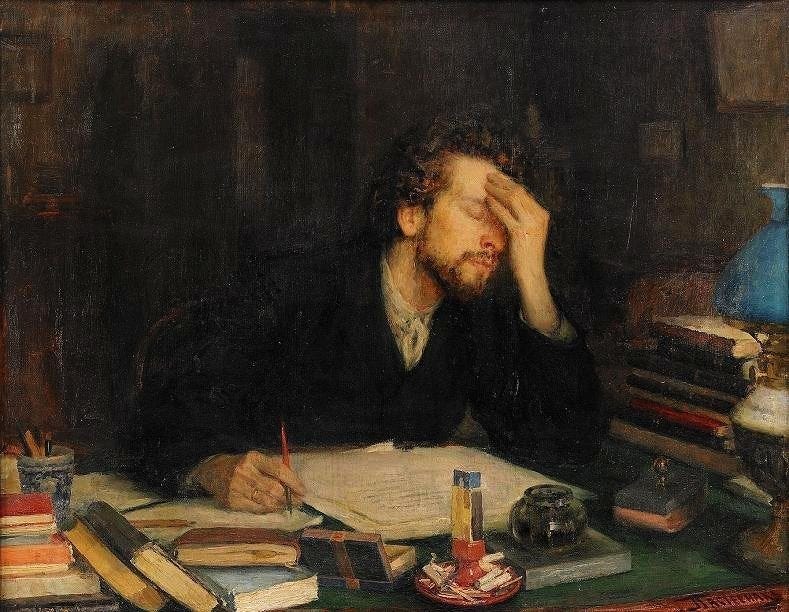Unofficial works have a great tradition. Before doctrine became the behemoth that it is, there were many writers meditating on the mysteries. And they sold their meditations to the masses of students and instructors via the inside covers of other such works. There are still excellent writers with tactical insight, procedural suggestions, fresh historical interpretations, and original theoretical nuance, but Officialdom is more reluctant to praise the ink of independent thought and non-doctrinally pure comment.
There is still an uptake of ‘hot takes’, as long as the fashionable words are used, and many staff officers read and share these commentaries. But they frequently lack the penmanship of Hamley, Henderson, Laffargue, Farrand Sayre, or Verdy Du Vernois. Or the infantry problems from the pens of A W Bjornstad and Major A W Valentine. Many of these old works once found themselves incorporated into instruction, or endorsed by schools and Officialdom.
If you want to find the modern equivalents of Unofficialdom, there are still plenty of great contributors: fiction from James R McDonough, interactive books from John F Antal, tactical problems from John Schmitt and Paul A Disney, theory from the likes of Robert Leonhard, Jim Storr, and Richard Simpkins, and practical advice for instructors from Robert B Rigg and Arthur S Collins. And MILSTACK.
One such remarkably good (and recent) unofficial publication is “The Art of Science”. Besides its delightful title, it brings a few ideas to the fore that would just not sit comfortably in the Official literature:
‘The critical path.’ The logical series of actions which must occur if success is to be achieved. It maintain focus for planning, but also tells you where your firepower must be concentrated - avoiding distraction.
High Explosive fixes infantry, but moves armour. Generally speaking.
In a defensive position, infantry will remain under cover no matter how great or little the weight of fire, as long as it is close. Mortars are as effective as 155mm in preventing the defenders from engaging the assaulting forces.
Dismounted infantry mounting an assault against trenches will seek to occupy those trenches as soon as possible in order to escape the effects of both friendly and enemy Indirect Fire.
You won’t see much of the enemy. They are on reverse slopes. This is why there must be a Forward Observation Officer in the assault - so that the depth of the objective can be fixed quickly and effectively.
Where there is one tank, there is a Troop.
Complimentary fire. When subject to Indirect Fire, the enemy will move, thus making them vulnerable to engagements from Direct Fire weapons. The inverse is also true:
Observers should not stick rigidly to the principle of only engaging large targets. The important factor in the engagement of any target is what effect the target is having on the operation. On occasions, single tanks or anti-tank posts can hold up the whole Battlegroup advance. A swift round of ‘Fire For Effect’ in the area is usually sufficient to make the vehicle move or give an opportunity to mount an assault.
A Major Dickie Winchester RA wrote this unofficial pamphlet while working at the British Army Training Unit Suffield (BATUS) in 1999. It was then updated in 2014 to reflect some doctrinal changes (not that that is necessarily bad - at the least it became a more gentle and accessible work to the contemporary reader).
Note how this smattering of insights captures both a style of generality that wouldn’t rest easy in Official writing, and, somehow, also has a useful tactical specificity. It admits of feeling for timeless truths, of wisdom. Its conclusions are definitive and yet open to the reader’s correction.
‘Unofficial Doctrine’ is a great kingdom. It’s greatness is derived from a few antagonist features it possesses compared to that Official stuff.
First, it is self-organising. The best sticks around. The Official is sustained by the authoritative demands for its consumption. Whereas Unofficial works, far from creating an anarchic landscape drowning in views, filters itself. That which is good is shared, and lives.
Second, it is not built by committee as Official doctrine tends to be. Unofficial works usually represent a single vision, and thus has a coherence that permits depth. The coherence that committee forms is typically shallow, it having prioritised consensus. A single horse outdoes an army of camels, metaphorically speaking.
Third, they are often filled with maxims and helpful memes that one would not otherwise encounter. Official works, by requiring ideas to be endorsed, leave such complexity and ambiguity out. Unofficial works tends to come with a recognition that the profession of arms is exploratory (and full of contradictory ideas). These maxims are useful ‘solutions’ to the paradoxes and uncertainty created by our attempt to dance within our chaotic arena.
Fourth, it is made from love. And that should be enough.
However, the most important feature of Unofficialdom is an ontological one. By the very fact of not being produced by the powers-that-be, it admits of its own limitations before it has even spoken. Our thirst for certainty cannot be quenched, and it is exactly this dry mouth that drives us and makes our pursuit so interesting. The Unofficial work says to the reader “these are merely my ideas, if that", and “here, what do you think?”
Unofficialdom is an expression of culture, with contributions from the people within it. There is no readily-grabbed consensus, but there is an embodied, intersubjective conversation, that is wrestling toward truth and the good.
“How monotonously alike all the great tyrants and conquerors have been: how gloriously different are the saints.”1
What Officialdom gets wrong is having an answer. To use Mcgilchrist terminology, it is ‘left hemisphere’. Helpful, and I am grateful, but stay in your proper place please.
There are no solutions, only ways. Unofficialdom is the way.
CS Lewis, Mere Christianity - Book IV, Chapter 11.




![Jean-Louis-Ernest Meissonier - Young Man Writing [1852] | Flickr Jean-Louis-Ernest Meissonier - Young Man Writing [1852] | Flickr](https://substackcdn.com/image/fetch/w_1456,c_limit,f_auto,q_auto:good,fl_progressive:steep/https%3A%2F%2Fsubstack-post-media.s3.amazonaws.com%2Fpublic%2Fimages%2F0b84b3f0-d795-4320-8b8c-6c000d3fb098_759x1024.jpeg)





1. Beautifully written.
2. If you haven’t read it yet, check out THE WANDERING ARMY, probably the best book I read this year. One of its primary themes is tracing some of these unofficial doctrines carried by RA officers.
3. Just before reading this, I was in FM 3-0 reading some of how the writers view defensive operations. It seems to me a lot more unofficial honestly is needed in those pages.
Stylish. 81 does suppress nearly as much as 155. "What matters most is the number of bangs." Military Operational Research Unit, 1946.